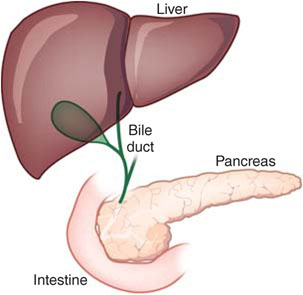The most common indication for liver surgery is to remove a cancerous tumor. Tumors of the liver may be metastatic, meaning they started at a different site (e.g. colon, kidney, etc.) or they may be primary, meaning they arise from within the liver (e.g. hepatocellular carcinoma or cholangiocarcinoma). Surgery to remove a liver tumor can relieve symptoms and restore health with potentially excellent long term results. If you have been diagnosed with a liver tumor, our surgeons can help determine what type of tumor you have and whether you would benefit from having your tumor surgically removed.
In addition, our team has extensive experience with tumor ablation. If your tumor is not able to be removed, you may be a candidate to have your tumor killed without removal by heating it using either radiofrequency or microwaves. This can be done with or without surgery, and your surgeon will help you decide which approach is best for you.

Liver adenoma is a benign but pre-cancerous tumor. Other types of benign (non-cancerous) liver tumors include hemangioma and focal nodular hyperplasia (FSH). Benign tumors may need to be removed surgically if they are pre-cancerous or when they cause symptoms such as pain or difficulty eating.
Liver cysts are collections of fluid within the liver. These are generally benign and often do not require surgery. When cysts are large they may cause pain or difficulty eating. Surgery can be used to cure symptoms when they impair quality of life or lead weight loss.
Pancreatic cancer affects an estimated 38,000 people each year in the United States. The best results with treatment are achieved when surgery is used for removal of the tumor. Unfortunately, only about 20% of people diagnosed with pancreatic cancer will be a candidate for surgical removal of their tumor at the time of diagnosis. Your surgeon can tell you if you are a candidate for surgery and what to expect around the time of surgery.
Pancreatic neuroendocrine tumors (islet tumors) are more slow growing tumors of the pancreas that can be either benign or cancerous. Neuroendocrine tumors should be removed surgically when they are at risk being cancerous or when they cause symptoms (e.g. diarrhea, flushing, light headedness, ulcers, skin rash, low blood suger, pain, weight loss, etc.).
Pancreatic cysts are fluid collections within the pancreas. These can be benign (e.g. pseudocysts, serous cyst adenoma) or pre-cancerous (e.g. mucinous cystic tumors and intraductal papillary mucinous neoplasms [IPMN]). Pancreatic cysts should be removed when they are large, cause symptoms including pain, inability to eat or weight loss, or when they have a risk of becoming cancerous. Your surgeon can help determine which type of cyst you have and whether or not you might benefit from having your cyst removed.
Pancreatitis refers to inflammation of the pancreas. This can be sudden (e.g. acute pancreatitis) or chronic (e.g. chronic pancreatitis). Pancreatitis can lead to blockage of the duct draining the pancreas resulting in diarrhea and weight loss. Other complications may include a build up of fluid around the pancreas (pseudocyst) and chronic pain. In cases of complicated pancreatitis, surgery may be helpful to treat your symptoms.
Many liver and pancreatic surgeries can now be done laparoscopically, using small "key hole" incisions. When done laparoscopically, liver and pancreatic surgery may result in less pain, as well as a shorter hospital stay and faster recovery.
© Dr. Parvinder S. Lubana. All rights reserved. | Developed & Design by ipromptsolution.com